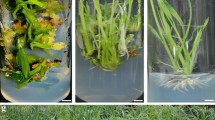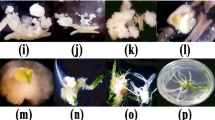Abstract
The low percentage of callus induction and green-plant regeneration has limited the application of anther culture techniques in indica rice breeding programmes. The aim of this work was to investigate the inheritance of the two characters and to determine whether good combinations with high-frequency callus induction and green-plant regeneration could be selected by sexual hybridization of suitable parents. So, a 3 × 4 incomplete diallel crosses were conducted between 7 parental lines. Three of them were believed to possess relatively high callus induction capacity and the other four relatively high green-plant regeneration capacity, based on our previous studies. Analysis of combining abilities and heritabilities revealed that both additive and non-additive effects were found to be important in the genetic control of callus induction. In case of green-plant regeneration, non-additive effects were predominant. Broad sense heritability values of 0.92 for callus induction and 0.98 for green-plant regeneration suggested that more than 90% of the observed variation was due to genetic effects, with just less than 10% attributed to non-genetic or environmental effects. In addition, the moderate narrow sense heritability values of 0.49 for callus induction, 0.29 for green-plant regeneration showed that the potential to introduce high responding ability into low lines was moderate. It was therefore conceivable that the frequency of anther culture response might be improved by suitable hybridization and selection strategies. A hybrid combination of code no. 67/107 incorporating high callus induction and high green-plant regeneration ability was selected in which genotype with high values of general combining ability (GCA) and positive effects of specific combining ability (SCA).
Similar content being viewed by others
Abbreviations
- 6-BA:
-
6-benzylaminopurine
- 2,4-D :
-
2,4-dichlorophenoxy acetic acid
- GCA:
-
general combining ability
- Kt:
-
kinetin
- MS:
-
Murashige and Skoog
- NAA:
-
naphthalene acetic acid
- SCA:
-
specific combining ability
References
Bishnoi U, Jain RK, Rohilla JS, Chowdhury VK, Gupta KR, Chowdhury JB (2000) Anther culture of recalcitrant indica × Basmati rice hybrids. Euphytica 114:93–101
Chaudhary HK, Dhaliwal I, Singh S, Sethi GS (2003) Genetics of androgenesis in winter and spring wheat genotypes. Euphytica 132:311–319
Chen Y, Zhuo QX, Wang RF, Zhang GH (1978) Selection of medium for indica/japonica hybrids anther culture by positive cross testing. Proceedings of anther culture symposium (1977). Science Press, Beijing, pp 65–72
Chen Y (1988) Rice anther and isolated pollen culture. In: Hu H, Chen Y (Eds) Plant somatic genetics and crop improvement. Beijing Univ. Press, Beijing, pp 27–67
Guiderdoni E, Galinato E, Luistro J, Vergara G (1992) Anther culture of tropical japonica × indica hybrids of rice (Oryza sativa L.). Euphytica 62:219–224
He P, Shen LS, Lu CF, Chen Y, Zhu LH (1998) Analysis of quantitative trait loci which contribute to anther culturability in rice (Oryza sativa L.). Mol Breed 4:165–172
He T, Luo K, Han SH, Guo XX (2003) Selection of high green-plant regenerating lines through rice anther culture. In: Khush GS, Brar DS, Hardy B (Eds) Advances in rice genetics. IRRI, Los Banos, pp 509–511
Henry Y, Vain P, De Buyser J (1994) Genetic analysis of in vitro plant tissue culture responses and regeneration capacities. Euphytica 79:45–58
Lazar MD, Baenziger PS, Schaeffer GW (1984) Combining abilities and heritability of callus formation and plantlet regeneration in wheat (Triticum aestivum L.) anther cultures. Theor Appl Genet 68:131–134
Li MF (1991) Anther culture breeding of rice. In: Yan CJ (Ed) Tissue culture of field crops. Shanghai Scientific and Technical Publishers. Shanghai, pp 135–152
Mei CS, Zhang JY, Wu GN (1988) Improving regeneration rate of anther culture in indica rice. Jiangsu J Agric Sci 4(2):45–48
Miah MAA. Earle ED, Khush GS (1985) Inheritance of callus formation ability in anther cultures of rice, Oryza sativa L. Theor Appl Genet 70:113–116
Mukherjee SG (1973) Genotype differences in the in vitro formation of embryoids from rice pollen. J Exp Bot 24:139–144
Murashige T, Skoog F (1962) A revised medium for rapid growth and bioassays with tobacco tissue culture. Physiol Plant 15:473–497
Niizeki H, Oono K (1968) Induction of haploid rice plant from anther culture. Proc Jpn Acad 44:554–557
Omar Faruque M, Farzana T, Seraj ZI, Sarker RH, Khatun AA (1998) Variations in green plant regeneration response from anthers of indica rice and their hybrids with japonica cv. Taipei 309. Plant Cell Tiss Org Cult 54:191–195
Oono K (1975) Production of haploid plants of rice (Oryza sativa L.) by anther culture and their use for breeding. Bull Natl Inst Agri Sci Ser D26:139–222
Powell W (1987) Diallel analysis of barley anther culture response. Genome 30:152–157
Quimio CA, Zapata FJ (1990) Diallel analysis of callus induction and green-plant regeneration in rice anther culture. Crop Sci 30:188–192
Shen JH, Li MF, Chen YQ, Zhang ZH (1982) Breeding by anther culture in rice varieties improvement. Sci Agric Sin 2:15–19
Tang QY, Feng MG (1997) Practical statistics and DPS data processing system. Science Press, Beijing
Wu CY, Chen Y (1987) A study of the genotypical differences in anther culture of keng rice (Oryza sativa subsp. Keng). Acta Genetica Sinica 14(3):168–174
Yamagishi M, Otani M, Higashi M, Fukuta Y, Fukui K, Yano M, Shimada T (1998) Chromosomal regions controlling anther culturability in rice (Oryza sativa L.). Euphytica 103: 227–234
Yan JQ, Xue QZ, Zhu J (1996) Genetic studies of anther culture ability in rice (Oryza sativa). Plant Cell Tiss Org Cult 45:253–258
Zhu J (1992) Mixed model approaches for estimating genetic variances and covariances. J of Biomath 7:1–11
Acknowledgements
The financial support provided by the Knowledge Innovation Project of the Chinese Academy of Sciences (KSCX2-1-01-2-01 and KSCX2-SW-304) is gratefully acknowledged.
Author information
Authors and Affiliations
Corresponding author
Rights and permissions
About this article
Cite this article
He, T., Yang, Y., Tu, S.B. et al. Selection of Interspecific Hybrids for Anther Culture of Indica Rice. Plant Cell Tiss Organ Cult 86, 271–277 (2006). https://doi.org/10.1007/s11240-006-9117-z
Received:
Accepted:
Published:
Issue Date:
DOI: https://doi.org/10.1007/s11240-006-9117-z




